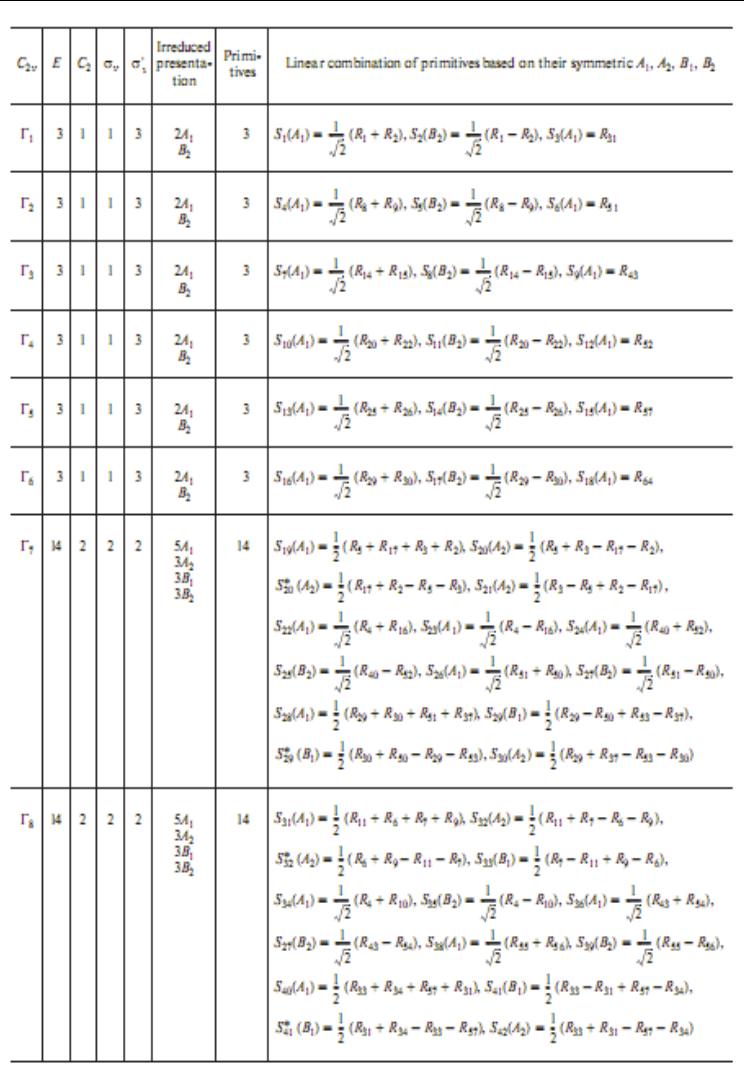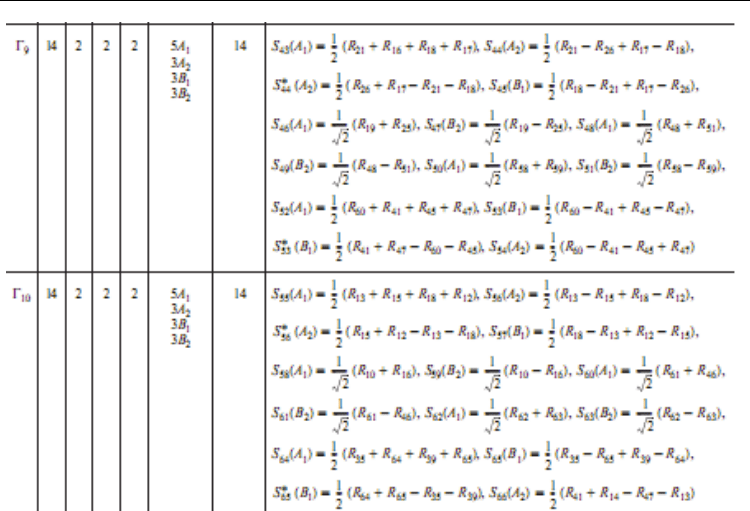Marulanda J.M. (ed.) Electronic Properties of Carbon Nanotubes
Подождите немного. Документ загружается.

26
Quantum Calculation in Prediction the
Properties of Single-Walled Carbon Nanotubes
Majid Monajjemi
1
and Vannajan Sanghiran Lee
2,3
1
Department of Chemistry, Science and Research Branch, Islamic Azad University, Tehran,
2
Department of Chemistry, Faculty of Science, University of Malaya, 50603, Kuala Lumpur,
3
Computational Simulation and Modeling Laboratory (CSML),
Thailand Center of Excellence in Physics, Commission on the Higher Education,
Ministry of Education, Bangkok,
1
Iran
2
Malaysia
3
Thailand
1. Introduction
Since the first discovery of single-walled carbon Nanotubes (SWCNTs) by Iijima and
Bethune in 1993 (Bethune et al., 1993), many applications as molecular components for
nanotechnology including conductivity and high-strength composites; energy storage and
energy conversion devices; sensors; field emission displays and radiation sources; hydrogen
storage media; and nanometer-sized semiconductor devices, probes, and interconnects are
known (Ajayan et al., 1994; Saito et al., 1997; deHeer et al., 1995; Collins et al., 1997; Nardelli
et al., 1998; Huang et al., 2006). SWCNTs have been considered as the leading candidate for
Nan device applications because of their one-dimensional electronic bond structure,
molecular size, biocompatibility, controllable property of conducting electrical current and
reversible response to biological reagents. Hence SWCNTs make possible bonding to
polymers and biological systems such as DNA and carbohydrates. Most SWCNTs have a
diameter of close to 1 nanometer, with a tube length that can be many millions of times
longer. The average diameter of a SWNT is 1.2 nm (Spires & Brown, 1996). However,
Nanotubes can vary in size, and they aren't always perfectly cylindrical. As in Fig. 1, the
average bond length and carbon separation values for the hexagonal lattice were shown.
The carbon bond length of 1.42 Å was measured by Spires and Brown in 1996 (Spires &
Brown, 1996) and later confirmed by Wilder et al. in 1998 (Wilder et al., 1998).
The structure of a SWNT can be formed by the rolling of a single layer of sp
2
carbon, called a
graphene layer, into a seamless hollow cylindrical tube with Nan scale dimensions of 1-1.5
nm. The length is usually in the order of microns to centimeters. Besides their unique
physical properties (elasticity, tensile strength, stiffness, and deformation), Nano tubes
exhibit varying electrical properties (depending on the direction that the graphite structure
spirals around the tube (quantified by the “Chiral vector”), and other factors, such as
doping), and can be superconductor, conductor (metallic), semiconductor or, insulator. The
band structure can even be further manipulated, by introducing defects into a tube. Single-

Electronic Properties of Carbon Nanotubes
576
walled nanotubes exhibit electric properties that are not shared by the multi-walled carbon
nanotube (MWNT) variants. In particular, their band gap can vary from zero to about 2 eV
and their electrical conductivity can show metallic or semiconducting behavior, whereas
MWNTs are zero-gap metals. The C-C tight bonding overlap energy is in the order of 2.5 eV.
Wilder et al. estimated it to be between 2.6 eV - 2.8 eV (Wilder et al., 1998) while at the same
time, Odom et al. estimated it to be 2.45 eV (Odom et al., 1998). Multi-walled carbon
nanotubes have a layer of carbon shells with differing physics that can all potentially
interact. It is shown that only the outer shell of MWCNTs contributes to electrical transport,
and so only small diameter MWCNTs could be used to make transistor devices. SWCNTs
are the most likely candidate for miniaturizing electronics beyond the micro
electromechanical scale currently used in electronics. As this field continues to expand and
grow, materials technology will produce products, components and systems that are
smaller, smarter, multi-functional, environmentally compatible, more survivable, and
customizable. These products will not only contribute to the growing revolutions of
information and biology, but will also significantly impact manufacturing, logistics, and our
culture as a whole. The development of scanning probe techniques has allowed not only the
microscopy of surfaces with atomic resolution, but also the manipulation of atoms and
molecules on surfaces, and many analytical techniques have been developed to allow
detailed characterization of materials and structures on the atomic level with unprecedented
accuracy. The utilization of materials with nanometer-sized structures will lead to
innovative products which are smaller, smarter, and more multi-functional. Therefore,
understanding of fundamental properties of structures at the nano scale with the aid of
computational models is important to design the specific material properties.
Fig. 1. The geometrical structure of SWCNT
1.42 Å
2.45 Å
2.83 Å
Armchair
a
1
a
2

Quantum Calculation in Prediction
the Properties of Single-Walled Carbon Nanotubes
577
Recently, theoretical and experimental work have predicted that the infinity length
SWCNTs are Pi-bonded aromatic molecules that the electrical properties depending upon
the tubular diameter and helical angle (Zhou et al., 2004; Baron et al., 2005). SWCNTs can be
chiral or nonchiral, again depending on the way of the rolling up vector. As a graphene
sheet was rolled in many ways in horizontal, vertical, and diagonal direction represent as
arrow vectors, a
, as in Fig. 1, the different types of carbon nanotubes were produced. The
three main types are armchair, zig-zag, and chiral nanotube. The geometrical and electronic
structure of SWCNT can be described by a chiral vector, the angle between the axis of its
hexagonal pattern and the axis of the tube which is presented by a pair of indices (n
1
,n
2
)
called the chiral vector. The integers n
1
and n
2
denote the number of unit vectors along two
directions in the honeycomb crystal lattice of graphene. When the indices are (n
1
,0) called
zig-zag, (n
1
, n
1
) called armchair, and (n
1
, n
2
) where n
1
0 and n
2
0 known as chiral SWCNT.
For (2 n
1
+ n
2
)/3 = integer, SWCNTs are metallic and others are semiconductors (Saito et al.,
1992a, 1992b). For large diameter SWCNTs defined by
22
1212
3( )
cc
nnnn
da
, where a
c-c
is the distance between neighboring carbon atoms in the flat sheet, armchair SWCNTs are
always metallic which is good for nanotechnology application. A zigzag carbon nanotube
(n
1
, 0), is a semiconductor when n
1
/3 integer. Such semiconductor zigzag carbon
nanotubes have the ability to become base of many nanoelectronic devices and transistors.
Although, scientific efforts focused on the electrostatics properties and commercial
applications of these materials (Ouyango et al., 2002; Kane & Mele, 1997; Hartschuh et al.
2005), there have been no experimental structural data sufficiently accurate for the
identification of the chirality indices of SWCNTs, especially for the kind of smaller diameter
nanotubes. In all experimental methods for the identification commonly utilized so far is
Raman spectroscopy and phonon dispersion. Phonon dispersion relations in one dimension
of this system have been studied by using zonefolding along one direction of Brillouin zone
considering the tube symmetry (Eklund et al., 1995). The tight binding electronic band
structure and the reverse of the diameter (1/d) dependence of the frequency of the radial
breathing mode (RBM) were employed (Jorio et al., 2001; Bachilo et al, 2002; Pfeiffer et al.
2003; Kurti et al., 2004; Maultizsch et al., 2005). The size and chirality of the carbon
nanotubes were typical determined from the SWCNT Raman energy spectra of a peak
around 150–300 cm
-1
, due to the radial breathing mode (Maultizsch et al., 2005; Jorio et al.,
2005). Further Raman studies of SWCNT modified by various reactions e.g. oxidation
reactions, ozonolysis, fluorination, residues modification (Srano et al., 2003; Umek et al.,
2003; Peng et al., 2003; Bahr et al., 2001; Holzinger et al., 2003; Mickelson et al., 1998; Cai et
al., 2002; Banerjee & Wong, 2002; Herrera & Resasco, 2003; Martinez et al., 2003) have
revealed that covalent functionalization mainly affects the intensity of the Raman bands.
Characterization of nanotube in adsorption gas has been studied by Monte Carlo and
Langevin Dynamic Simulation (Monajjemi et al., 2008b). It is also important to investigate
the effects of diameter on a SWCNT structure how the diameter depends on geometrical
parameters such as the C-C bond lengths and some of the dihedral angles of SWCNTs.
For a better understanding of the physical and electronic properties of SWCNT, a
challenging task in theoretical calculation is needed to specify the material properties
because of the large size of the SWCNTs and their complicated (and size-dependent)
electronic structure. Quantum calculation in prediction the properties of single-walled
carbon nanotubes (SWCNTs) will be discussed.

Electronic Properties of Carbon Nanotubes
578
2. Vibrational mode of SWCNT
Normal mode analysis has become one of the standard techniques in the study of the
dynamics of nanotubes. It is primarily used for identifying and characterizing the slowest
motions in a poly system, which are inaccessible by other methods. This text explains what
normal mode analysis is and what one can do with it without going beyond its limit of
validity. By definition, normal mode analysis is the study of harmonic potential wells by
analytic means. The first section of this study will therefore deal with potential wells and
harmonic approximations. This study is about normal mode approaches to different
physical situations, and it discusses how useful information can be extracted from normal
modes. Normalmode coordinates are obtained by a linear combination of Cartesian
coordinates. Thus, there are no couplings in the kinetic part; that is, they diagonalize the
kinetic energy as well the quadratic part of the potential energy operator. They include
simultaneous motion of all atoms during the vibration, which leads to a natural description
of molecular vibrations. Therefore, they are good candidates for representation of the
molecular Hamiltonian. Since a transformation between different sets of coordinates is
possible, the anharmonic terms can be calculated in one representation, and then
transformed into another one.
2.1 Symmetry of SWCNT
Because a single carbon nanotube may be thought of as a graphene sheet rolled up to form a
tube, carbon nanotubes should be expected to have many properties derived from the energy
bands and lattice dynamics of graphite. For the very smallest tubule diameters, however, one
might anticipate new effects stemming from the curvature of the tube wall and the closing of
the graphene sheet into a cylinder. A method for identifying the Raman modes of single-wall
carbon nanotubes (SWNT) based on the symmetry of the vibration modes has been widely
used. The Raman intensity of each vibration mode varies with polarization direction, and the
relationship can be expressed as analytical functions. Each Raman-active mode of SWNT can
be distinguished from the group theory principle. The symmetry properties of periodic lattices
of carbon nanotubes and the symmetry operations of chiral and achiral nanotubes
(Damnjanović et al., 1999; Damnjanović et al., 2001; Alon, 2001, 2003) are usually described in
terms of the group of the wavevector (Dresselhaus et al., 2006). However, since nanotubes can
be viewed as quasi-1D systems, the line groups approach by Damnjanović et al. is suited to
describe nanotube properties (Damnjanović et al., 1999).
As described earlier, the properties of nanotubes are determined by their diameter and
chiral angle, both of which depend on n
1
and n
2
. Typically, SWCNT is presented by a pair of
integers (n
1
, n
2
). Its geometrical structure as shown in diagram can be represented in term of
a chiral vector
C
on a two-dimensional sp
2
-carbon sheet where
11 22
Cnana
with integer
n
1
and n
2
. Here,
1
a
and
2
a
represent the unit vectors of the hexagonal graphene lattice. This
sheet is then rolled up to a cylinder so that
C
becomes the circumference of the tube. The
direction of the nanotube axis is naturally perpendicular to
C
. The diameter, d, is simply the
length of the chiral vector divided by ¼, and
22 1/2
1212
3/ ( )
cc
dannnn
, where a
c-c
is
the distance between neighbouring carbon atoms in the flat sheet. In turn, the chiral angle
() is given by
1
21
tan 3 /(2 )nnn
.

Quantum Calculation in Prediction
the Properties of Single-Walled Carbon Nanotubes
579
The translational period,
a, is the shortest possible lattice vector along z direction. The
translatory unit cell of a nanotube is a cylinder with a length in tube axis direction equal to
the magnitude of the translation vector
T
as shown in Fig. 1 which can be calculated as
following equation:
21 12
12
22nn nn
aaa
nR nR
with
22
1212
0
3( )
||
nnnn
aa a
nR
where n is the greatest common divisor of n
1
and n
2
,
if (n1 -n2)/3n ≠ integer, then R = 1
if (n1 -n2)/3n = integer, then R = 3
and
1
a
and
2
a
form an angle of 60
o
and their length is | a
1
| = | a
2
| = a
0
= 2.461 Å
Since the translational period, a, depends inversely on n and R the translation periodicity
and thus the number of carbon atoms varies strongly for tubes with similar diameter. The
number of graphene cells in the nanotube unit cell (n
c
) obtained from:
22
1212
24
c
nnnn
nq
nR
The groups of infinite line L are products L = ZP, where P is a point group and Z is the
group of translations (screw axis, pure translations, and glide planes). Applying the above
symmetry formulation to armchair (n
1
= n
2
) and zigzag (n
2
= 0) nanotubes, such nanotubes
with no caps have a isogonal point groups given by q (the number of graphene cells in the
unit cell of the nanotubes) namely, D
nd
when n is odd, D
nh
when n is even, or Dqh = D2nh for
achiral and Dq for chiral tubes. Whether the symmetry groups for armchair and zigzag
tubules are taken to be D
nd
or D
nh
, the calculated vibrational frequencies will be the same;
the symmetry assignments for these modes, however, will be different. It is, thus, expected
that modes that are Raman or IR-active under D
nd
(or D
nh
) but are optically under D2nh will
only show a weak activity resulting from the fact that the existence of caps lowers the
symmetry that would exist for a nanotube of infinite length.
2.2 Active modes of Raman and IR
The phonon symmetries are found by decomposing the dynamical representation into its
irreducible representations using symmetries of carbon and other nanotubes studied for line
groups (Damnjanović et al., 1999). One direct set up of the dynamical representation from
the atomic and vector representation is to use factor group analysis. A representation can be
decomposed into the sum of its irreducible representations by the following formula
()
()
1
()* ()
DG
G
f
GG
g
where f is the appearance frequency of the irreducible representation , g is the order of
the symmetry group; the sum is over all symmetry operations G.

Electronic Properties of Carbon Nanotubes
580
The Raman
R
and infrared active
IR
vibrations transform according to the representation
of the second rank tensor and the vector representation, respectively (Damnjanović et al.,
1983)
R
= [
vec
vec
] = A
1g
E
1g
E
2g
(
A
2g
)
IR
=
vec
= A
2u
E
1u
According to the symmetries of Raman-active modes (Pelletier, 1999) for the armchair
carbon nanotube with the chair vector (n1, n2), the point group for this kind nanotube
belongs to Dnh when n is even and its Raman-active modes are denoted by A1g + E1g +
E2g. Three flavors of modes are longitudinal, transversal radial (orthogonal to tube surface)
and transversal axial (parallel to tube surface). Satio et al. (Satio et al., 1998) pointed out that
the low frequency A1g mode is a radial breathing mode and two high frequency is belong to
Eg modes, E1g and E2g. E mode has the same displacement pattern with additional
standing wave on the circumference.
2.3 Projection operators
The zigzag single-walled carbon nanotubes (SWCNTs) with (3,0), (4,0), and (5,0) structure
were built using the tool in HyperChem7.0. The symmetries of the nanotube are D3d, D4d,
and D5d respectively. Four different systems were studied in this work as follow: (1) gas-
phase SWCNT, (2) SWCNT with 23 water molecules in the a x b x c box, (3) SWCNT with 23
methanol molecules in the a x b x c box, and (4) SWCNT with mixed solvent of water and
methanol molecules in the a x b x c box. Energy minima of systems (2) – (4) were carried out
by Metropolis Monte carlo (MC) calculation which generate random configurations in
regions of space that make the important contributions to the calculation of thermodynamic
averages. Then the ab initio and semiemperical with AM1 were used to optimize the
structure of the nanotubes. All the normal mode frequencies and IR intensity were
calculated using the optimized structures.
To find a function or the displacement pattern of eigenvectors transforming as a particular
irreducible representation, the projection operators in group theory have been applied.
Consider an arbitrary function F. This function can, in general, be expanded into several
irreducible represent ations
nn
n
Fc
where labels the irreducible representations,
n
c
are the coefficients of the expansion, and the
n
are functions transforming according to
the representation . A projection operator defined by
()
() ()
() ln
()*()
G
ln
d
PDGG
g
applied
to F picks out the symmetry adapted function
()
l
. In equation
d
is the degeneracy of the
irreducible representation , g the order of the symmetry group, G are the symmetry
operations, and
()
ln
D
ln is the lnth element of the representation matrix
()
D
. From a given
function, and its irreducible presentation, functions can be generating if that function has a
“component” or a “non-zero projection” along the irreducible presentation of interest. This
explains the name of “projector”. As an example, if there is an orthonormal set Li of the
function
i
1
,
i
2
,…,
i
Li
which is used to form the i
th
irreducible representation of a group by
order h, for each operator,
R, in the group, by definition we can have:

Quantum Calculation in Prediction
the Properties of Single-Walled Carbon Nanotubes
581
R
i
t
= Σs
i
s
Γ(R)
i
st
(1)
By producting (1) in [Γ(R)
i
s
t
]
*
and summing all over the symmetrical functions in the group
we will have:
Σ
R
[Γ(R)
i
s
t
]
*
R
i
t
= Σ
R
Σ
s
Γ
i
s
Γ(R)
i
st
Γ(R)
i
s
t
]
*
(2)
Considering
i
s
are functions independent from R, the right side of (2) can be written as:
Σ
s
i
s
Σ
R
Γ(R)
i
st
[Γ(R)
i
s
t
]
*
So we have a series of Li terms and each of them are equal to a
production of
i
s
and a coefficient. These coefficients are following the orthogonality rule:
Σ
R
Γ(R)
i
st
[Γ(R)
i
s
t
]
*
= h/(L
i
L
j
)
1/2
δ
ij
δ
ss
δ
tt
(3)
By use of the eq.(3), the eq.(2) is simplified as follows:
Σ
R
Γ(R)
i
s
t
]
*
R
i
t
= (h/L
j
)
i
s
δ
ij
δ
tt
(4)
Now, by introducing
P
j
s
t
= L
j
/h Σ
R
Γ(R)
i
st
[Γ(R)
i
s
t
]
*
R (5)
The eq.(4)gives the following form:
P
j
s
t
i
t
=
i
s
δ
ij
δ
tt
(6)
The
P
j
s
t
is call projection operator. The application of this operator on each
i
t
is non-zero
only when this function or some of its terms is a function of
i
s
. One of the most important
application of this operator is projecting function
i
t
from any function
i
t
. In other words
P
j
t
t
i
t
=
i
t
δ
ij
δ
tt
(7)
By use of the projection operator on the base of L
j
diagonal elements of a matrix, we can
have some
i
t
functions, which are the bases for the j
th
irreducible presentation (Wilson, et
al., 1955)
2.4 The relation between projection and transfer operators
Assume that Γ
k
(p)
ij
is the ij
th
element of the matrix which shows the p
th
operator (Op) in
k the k
th
irreducible presentation. By this assumption the operator O
k, ij
is defined as
follows
O
k,ij
= L
k
/ h Σ
p
Γ
k
(p)*
ij
Op (8)
Where h is group order and L
k
is the presentation dimension. If i = j these operators called
Projection operators,
P
k,ii
, in other words:
P
k,ij
= O
k,ii
(9)
The non- diagonalized operators are called Transfer operators or shift operators,
T
k,ij
= O
k,ij
, ij (10)
In one-dimensional presentations
P
k,ij
and O
k,ii
are the same and we have no T
k,ij
. With use of
the above definitions, making the irreducible basis becomes possible in the following way:

Electronic Properties of Carbon Nanotubes
582
At first the point group of the molecule is determined.Then the character of the system
(Γ
angles
or Γ
bonding
) is calculated. By use of the standard reduce formulation these characters
can be reduced to give the irreducible presentations:
n
Γ
= 1/h Σ
g
n
g
χ
R
χ
Γ
(11)
Where h is the order of the group, n
g
is the number of the symmetry operation in the class of
g, χ
R
is the character of reducible presentation and χ
Γ
is the character of irreducible
presentation for the symmetric operations of class g. In this part there is a note about the
reducing the C
v
and D
h
point groups. The method of reduce is a different from the normal
method of reduce. For more information see from the references (Cotton, 1971; Schafer &
Cyvrin, 1971; Strommen & Lippincott, 1972; Alvarino, 1978; Flurry, 1979; Strommen, 1979).
At the next step, the interested function is written by use of the projection operator. A set of
the results gives the internal coordinate system for a given point group. There are several
examples to illustrate this procedure in Table 1. The geometry and electrical properties of
nanotube are very sensitive to dielectric constants. The normal modes also will be changed
in the high dielectric constants. With the calculation of the normal modes using the U Matrix
it is possible to get the F Matrix from the multiplication of frequency to the U Matrix.
Solving the determination of F Matrix versus dielectric can be useful for understanding of
the electrical behavior of nanotubes in the quantitative structure activity relationship
(QSAR) studies. With use of the resulting coordinate system, the U Matrix (UMAT) can be
written easily. These are matrices which perform the linear transformations on the internal
coordinates sets (Alvarino & Chammoro, 1980).
2.5 Linear combination of primitive’s harmonic vibrations and UMAT
The molecules and their internal coordinates of D4d have been given in Fig. 2. By following
the above steps a complete set of the linear combinations and their normalization
coefficients are achieved. The irreducible representations of the symmetry group are given
by A and B. These data are given in Table 1. We use the application of projection operator
method in finding the coordinate system, and by using it the U matrix is written and finally
the frequencies and distributions of peak position are achieved. The (3, 0), (4, 0), (5, 0) zig-
zag nanotubes were investigated. They have 66, 138, and 174 normal modes, respectively.
Fig. 2. The structure of (4, 0) nanotube in D
4d
point group (Lee et al., 2009)

Quantum Calculation in Prediction
the Properties of Single-Walled Carbon Nanotubes
583

Electronic Properties of Carbon Nanotubes
584
Table 1. The combination and their normalization coefficients of (3,0) nanotube in D3d point
group (Lee et al., 2009)
The character of the system assigned by Γ was calculated from the character tables and the
UMAT are written from the application of projection operator. Vibrational Calculation was
carried out by the MOLVIB algorithms and by Hyper Chem. Calculation and a few sets of
calculation were performed. Molecular motions can be assigned by the potential energy
distribution (PED) analysis among internal coordinates by the method of the projection
operator. There are good agreements between the most cases.
2.6 Normal mode dependence on dielectric
As can be inferred from Table 1 and the Fig. 3, 4, and 5, there are good agreements between
the semi and Monte Carlo and even ab initio calculation. In Table 1 the various of intensity
and frequency and potential energy from different methods are shown versus the inverse
dielectric for some normal modes. From Fig. 3 we have two maximum for both of energy
and frequency in the dielectric between 77.40 up to 70.42 and also the third maximum is
located in the 61.76. This region range is considered to be the unstable geometry of
nanotubes which are very sensitive to dielectric. After these range the frequency, intensity
and energy goes toward a stable geometry which are not sensitive to dielectric. The same
results are obtained in the insets Fig. B and C of Fig. 3 for D3d of normal mode 61 and 66
respectively. In the Fig 4, similar to normal mode 1 and 131 and 138 are shown with A, B,
and C respectively for nano tube (4 0) in D4d point group, a common general behavior is
observed in this nanotube as same as (3 0) nanotube, only with a shift in data, this shift is
due to the difference between the geometrical structures of two nanotubes.
